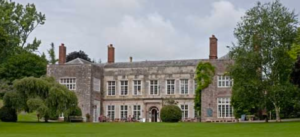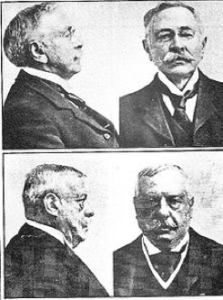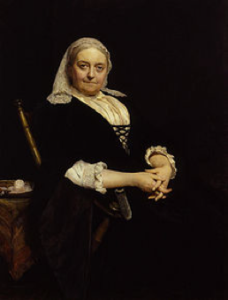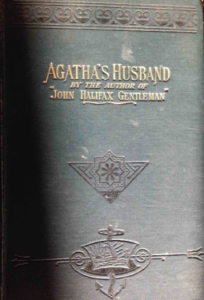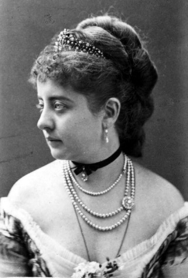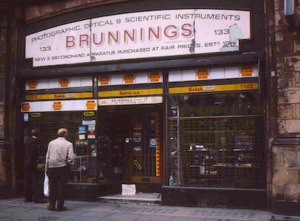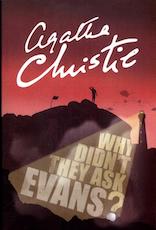
Poirot Score: 58
Why Didn’t They Ask Evans?
☆☆
Reasons for the Poirot Score
This is one of Christie’s adventure stories although there is a whodunnit element. There is only one hard clue, and a very small number of suspects and so it scores relatively poorly on our criteria. The story is well told and good fun but to be enjoyed more as a rollicking good yarn than as a whodunnit puzzle.
Click here for full review (spoilers ahead)
Trivia
Dedication
To Christopher Mallock in memory of Hinds
In 1912 Agatha ‘in voluminous harem trousers’ [Janet Morgan p45] played the part of Sister Anne in a private amateur performance of a play based on A Thousand and One Nights. The first Act was called Why Did They Bag-Dad? The play was put on at Cockington Court, near Torquay, the grand house of Agatha’s friends, the Mallocks. Mrs Mallock played Scherazade. Cockington Court came under the control of Torbay Borough Council in 1933 – just when Agatha Christie was writing Evans. It is now an arts and crafts centre open to the public. According to the Agatha Christie ‘Riviera’ literary trail website Christopher Mallock was one-time owner of Cockington Court [http://www.englishriviera.co.uk/agathachristie/things-to-do/cockington-village-and-country-park-p140183].
In chapter 1 Bobby is described as follows: “His best friend could not have said that he was handsome, but his face was an eminently likeable one, and his eyes had the honest brown friendliness of a dog’s.”
Christie loved dogs and we imagine that Hinds was a dog, but we have no direct evidence for this.
Cockington Court
[http://www.devonheritage.org/Places/Cockington/IndexforCockington.htm]
8 grains of morphia
When we were medical students the British National Formulary gave dosages of morphine in grains. Bobby consumes 8 grains of morphia – put in his beer in order to try and kill him. It is surprising he survived. One grain is about 65mg. Eight grains are therefore around 520 mg of morphine. Modern dosages might begin at 10 mg although they may be increased considerably for severe pain and discomfort. But 520 mg is a huge dose by anyone’s standards.
A St Martin’s Summer
‘The weather is very delightful just now, is it not? A St Martin’summer’
[Chapter 24]
A St Martin’s Summer is a period of good weather in October or November. In modern British English the term is rare and has been replaced by the US phrase Indian Summer (referring to North American ‘Indians’). St Martin’s Day is November 11th. Many European languages use the phrase St Martins Summer. St Martin was born in 316AD and became Bishop of Tours. He shared his cloak with a poor man and is the patron saint of beggars.
Adolf Beck, and Lyons Mail
‘”I wonder if everyone has a double.”
They compared instances, citing Adolf Beck and referring lightly to the Lyons Mail.’
[Chapter 14]
The Adolf Beck case led to the creation of the English Court of Criminal Appeal. It involved a miscarriage of justice, the evidence of a circumcision, and Sir Arthur Conan Doyle (see http://en.wikipedia.org/wiki/Adolf_Beck_case).
Beck was convicted in 1896 at the Old Bailey in London of defrauding many women of jewelry. Much of the case against him depended on the victims of the frauds identifying Beck as the fraudster in an identity parade. Almost 20 years earlier a man known as John Smith had been found guilty of a very similar style of fraud and sentenced to five years in prison. It was assumed that Smith and Beck were the same person. However in 1898, while Beck was in prison, the prison records of Smith were examined. Smith, but not Beck, had been circumcised. The Home Office acknowledged that Beck was not Smith but did not allow Beck’s conviction for the fraud cases of the 1890s to be re-examined. Conan Doyle was one of those calling for a re-examination of the case. Beck was allowed out of prison on parole in 1901. He was arrested again for similar fraud in 1904. Again the main evidence against him was identification by the victim. Beck was tried again at the Old Bailey and found guilty but the judge, Sir William Grantham, was unhappy with the conviction and delayed sentencing. Beck returned to prison to await sentence. While in prison a man, William Thomas, was arrested for trying to swindle some actresses of jewelry. The detective who had been present at Beck’s two trials and knew he was in prison noticed the resemblance of Beck to Thomas. It turned out that Thomas was also Smith, and at his trial he admitted to having committed the crimes for which Beck had been convicted.
Beck was given a pardon and some compensation and a committee of inquiry was set up that led to the creation of the Court of Criminal Appeal. The case also led to concerns about the value of eyewitness identification.
Beck (top photos) and ‘Smith’ (bottom photos)
[http://en.wikipedia.org/wiki/Adolf_Beck_case]
The Courrier de Lyon case involved robbery and the murder of the driver and guard of a mail coach travelling from Paris to Lyon in 1796. One of those found guilty (and guillotined) was probably wrongly identified by witnesses as involved in the crime due to his resemblance to the actual perpetrator. Christie is referring to the film of the case – The Lyons Mail – which was made in Britain in 1931.
‘John Halifax, Gentleman’, Ouida
In Chapter 7 we learn that while Bobby is in hospital recovering from being poisoned by morphia there is a table with the book John Halifax, Gentleman and a novel of Ouida’s.
John Halifax, Gentleman is a novel by Dinah Craik first published in 1856. It was hugely popular and it is the only novel that my father remembered his father (who was born in the 1890’s) mentioning. It is the story of a poor boy who makes good. Dinah Craik also wrote a novel called Agatha’s Husband which starts: “Agatha – If there ever was a woman thoroughly like her name, it was Agatha Bowen”. Agatha Bowen was “good” although with “a slight external roughness”. She had a character in which there “was nothing small, mean, cramped, or crooked” – just like the sound of the name Agatha, we are told: “ .. the three broad rich a’s – which no one can pronounce with nimini-pimini closed lips”. Agatha Christie’s mother so liked the novel that she named her second daughter after its heroine. In our copy of Agatha’s Husbandpublished around 1900 there is no mention of the author’s name. It simply states: “By the author of John Halifax, Gentleman”
Dinah Craik
[http://en.wikipedia.org/wiki/Dinah_Craik]
Ouida was the pen-name of another popular British female Victorian novelist whose real name was Maria Louise Ramé. Like Agatha Christie she was very fond of dogs and horses. Her memorial in Bury St Edmunds in Suffolk, England (where she was born), has a drinking trough. The inscription reads: “Her friends have erected this fountain in the place of her birth. Here may God’s creatures whom she loved assuage her tender soul as they drink.”
Ouida
[http://en.wikipedia.org/wiki/File:Ouida_from_Cabinet_Card.jpg]
The British Museum Underground Station
‘The train drew up at a station and Frankie saw that it was the British Museum. She had overshot Oxford Circus, where she meant to have changed, by two stations.’
Those familiar with London’s current underground system may be puzzled by this. There is no station called British Museum. If you overshoot Oxford Circus by two stations travelling East (as Frankie was doing) you get to Holborn station. The British Museum station is another of London’s ‘lost’ underground stations (see Trivia for The Mystery of the Blue Train and The Secret Adversary). Dover Street station was renamed Green Park (and the entrance shifted); Down Street station was completely closed; and the British Museum station was, essentially, shifted along the line. The station was first opened in 1900 by a company that ran what is now the Central Line, and closed in 1933 presumably very shortly after Christie was writing Evans(and the year before the novel was first published). In 1906 Holborn underground station was opened, about a hundred yards to the east of the British Museum station and by the company which ran what is now the Piccadilly Line. When Holborn station was upgraded to include escalators in the early 1930s new platforms were added for (what is now) the Central Line and the British Museum station was closed. This enabled passengers to change from one line to the other.
The British Museum station is now completely rebuilt as Nationwide House, I33 High Holborn, on the the north side of the road just to the west of Southampton Place and almost opposite where Newton Street meets High Holborn. When I was growing up in London in the 1950’s and 1960’s the outline of the station was still visible and part of the site was occupied by Brunnings (see: http://www.abandonedstations.org.uk/British_Museum_station.html and John Hart’s story of finding the station beneath Brunning’s shop at http://www.environmentalgraffiti.com/offbeat-news/four-abandoned-stations-of-the-london-underground/1089]. Brunnings was an Aladdin’s cave of optical instruments: second-hand cameras, telescopes and microscopes, some very old and valuable. In the early 1960’s my parents bought me an early twentieth century microscope from Brunnings for Christmas. It was the best Christmas present I had ever had. Beautiful brass lens cases, black coated metal housing, and a lockable wooden box to keep it safe. Sadly Brunnings closed in the 1980s.
Brunnings in 1981 [http://www.flickr.com/photos/ralphstephenson/5201400550/sizes/o/in/photostream/]


